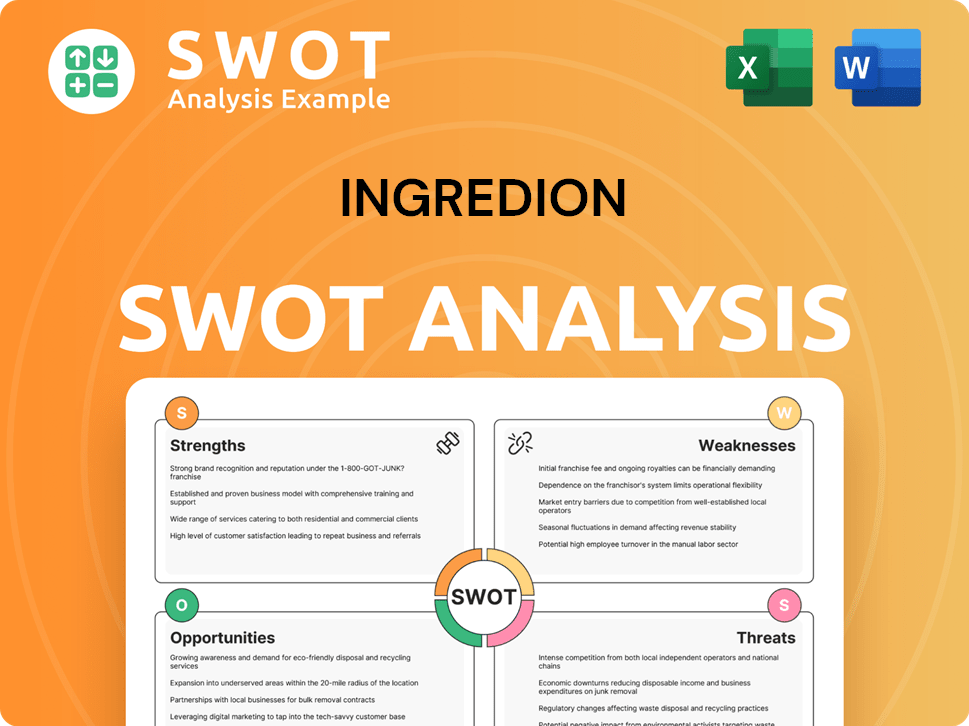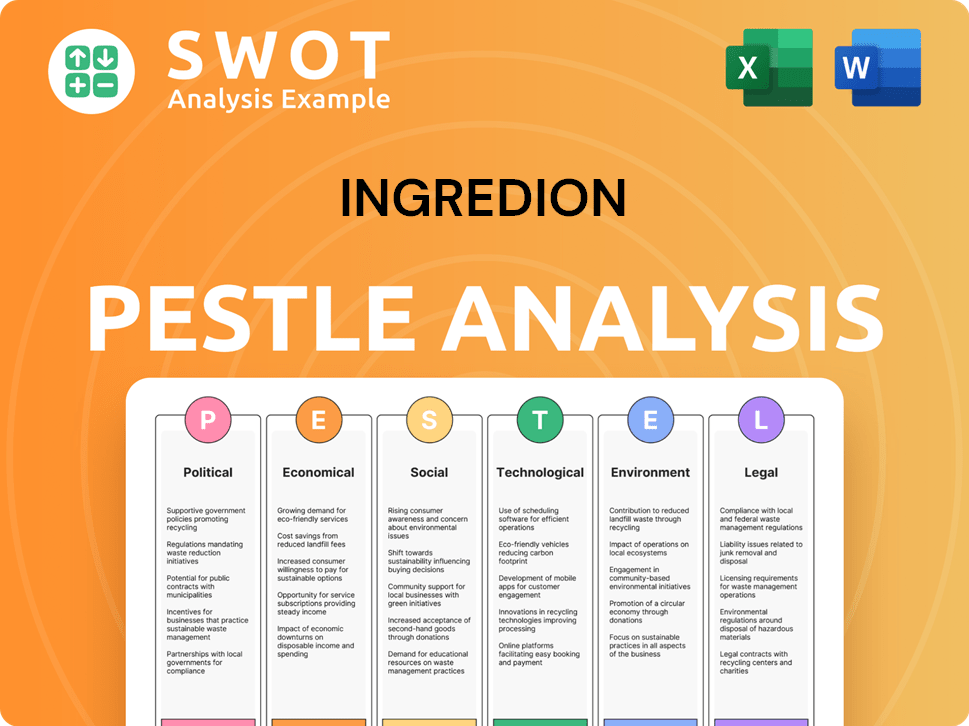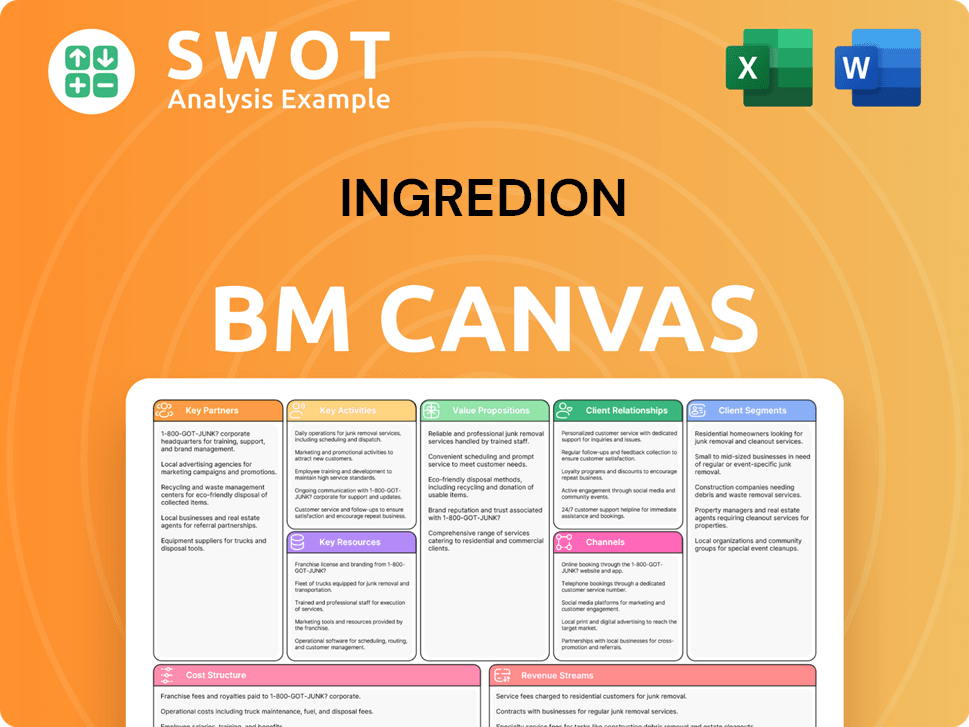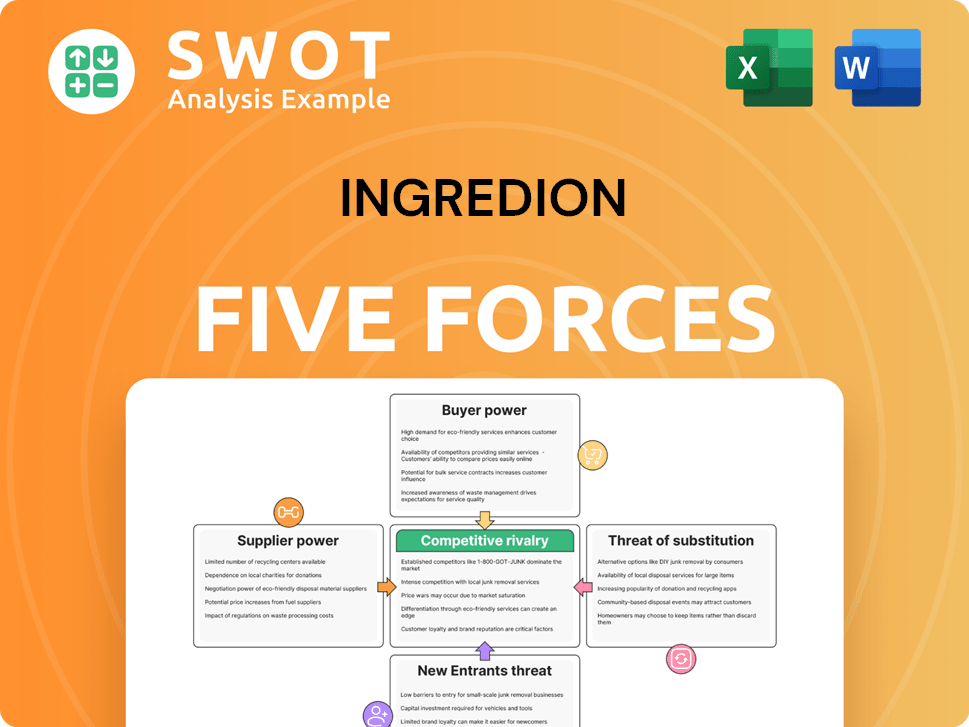Ingredion Bundle
Who Really Owns Ingredion?
Uncover the ownership secrets of Ingredion, a global leader in ingredient solutions. Understanding Ingredion SWOT Analysis is key to grasping its market position and strategic direction. From its roots as a corn refiner to a diversified ingredient provider, Ingredion's journey is a testament to strategic evolution.

Knowing who owns Ingredion, from its major shareholders to the influence of its executives, offers critical insights into its future. This exploration into Ingredion's ownership structure will reveal how the company's trajectory has been shaped by its investors and the dynamics of the stock market. Discover the answers to questions like "Who are Ingredion's major shareholders?" and "Is Ingredion a public company?" to make informed decisions about Ingredion stock and its financial performance.
Who Founded Ingredion?
The story of Ingredion begins in 1906 with the formation of the Corn Products Refining Company. This was a significant event, born from the merger of several leading U.S. corn refiners. While the exact details of the initial ownership structure are not widely available in public records, the merger itself indicates a consolidation of ownership from the existing businesses.
Edward T. Bedford played a key role in the creation of the Corn Products Refining Company, later becoming its president. The company's early vision was to dominate the corn refining industry. This ambition is evident in the early production of products like Argo laundry cornstarch, introduced in 1908, and Mazola corn oil, which followed in 1911.
The company was incorporated in New Jersey. Early expansion included acquiring the Canada Starch Company in 1919. Early growth also involved patenting crystalline dextrose, sold as Cerelose, and establishing refining operations in South America and Mexico during the 1920s.
The company's early product lineup included Argo laundry cornstarch and Mazola corn oil. These products were key to establishing its presence in the market.
Ingredion quickly expanded beyond the U.S., acquiring Canada Starch Company in 1919. Operations were also established in South America and Mexico during the 1920s.
Edward T. Bedford was instrumental in the formation of the Corn Products Refining Company and later served as its president.
The company patented crystalline dextrose, sold as Cerelose. This innovation helped diversify its product offerings.
The initial vision was to establish a dominant force in corn refining. This goal guided the company's early strategies and investments.
The company was incorporated in New Jersey, marking the formal beginning of its operations.
Understanding the Ingredion company history involves looking at its early ownership structure, which stemmed from a merger of corn refiners. While specific founder details are limited, the company's initial strategy focused on product diversification and geographic expansion. Early products like Argo and Mazola helped establish the company's market presence. The acquisition of Canada Starch Company and the establishment of operations in South America and Mexico were key steps in its early growth. The patenting of Cerelose also played a role in its expansion.
- The Corn Products Refining Company was formed through a merger of existing corn refiners.
- Edward T. Bedford was a key figure in the company's early development.
- Early products included Argo laundry cornstarch and Mazola corn oil.
- The company expanded geographically through acquisitions and new operations.
Ingredion SWOT Analysis
- Complete SWOT Breakdown
- Fully Customizable
- Editable in Excel & Word
- Professional Formatting
- Investor-Ready Format

How Has Ingredion’s Ownership Changed Over Time?
Ingredion Incorporated, a publicly traded entity on the New York Stock Exchange (NYSE) under the ticker symbol INGR, has a shareholder base largely composed of public investors. The company's journey to becoming an independent public entity began on December 31, 1997, when it was spun off from CPC International, marking a significant shift in its ownership structure. This transition set the stage for Ingredion's evolution, including strategic acquisitions and expansions that have shaped its current ownership landscape.
Ingredion's ownership structure reflects a diverse group of shareholders, with a substantial portion held by institutional investors. As of March 31, 2025, there were 1,255 institutional owners and shareholders who have filed 13D/G or 13F forms with the SEC. These entities collectively held 72,778,947 shares. Key institutional shareholders include Vanguard Group Inc., BlackRock, Inc., Dimensional Fund Advisors LP, and State Street Corp. The company's outstanding shares were 64,185,927 as of February 14, 2025, highlighting the significant influence of institutional investors on the company's stock.
| Shareholder | Shares Held (as of March 31, 2025) | Percentage of Ownership |
|---|---|---|
| Vanguard Group Inc. | 7,244,386 | 11.29% |
| BlackRock, Inc. | 6,977,983 | 10.37% |
| Dimensional Fund Advisors LP | 2,755,683 | 4.119% |
| State Street Corp | 2,503,055 | 3.9% |
Ingredion has strategically expanded its operations through acquisitions and joint ventures, influencing its capital structure and market reach. These strategic moves have diversified its product portfolio and broadened its global footprint. For example, the acquisition of National Starch in 2010 for $1.3 billion, Penford Corp in 2015 for $340 million, and Kerr Concentrates in 2015 for $100 million. More recently, Ingredion acquired PureCircle Limited and Verdient Foods. These acquisitions have impacted the company's overall valuation and the strategic interests of its major stakeholders. The company's market capitalization was $8.89 billion as of June 11, 2025. For more insights into the company's strategic direction, you can explore the Target Market of Ingredion.
Ingredion's ownership structure is primarily public, with significant institutional investor involvement.
- The company became independent in 1997 after being spun off from CPC International.
- Major institutional shareholders include Vanguard Group Inc. and BlackRock, Inc.
- Strategic acquisitions have diversified Ingredion's product offerings and global presence.
- Ingredion's market capitalization was $8.89 billion as of June 11, 2025.
Ingredion PESTLE Analysis
- Covers All 6 PESTLE Categories
- No Research Needed – Save Hours of Work
- Built by Experts, Trusted by Consultants
- Instant Download, Ready to Use
- 100% Editable, Fully Customizable

Who Sits on Ingredion’s Board?
The Board of Directors at Ingredion, a key aspect of understanding Ingredion ownership, is responsible for overseeing the company's strategic direction and governance. As of the 2025 Annual Meeting of Stockholders, held virtually on May 21, 2025, shareholders were to elect 11 director nominees, each serving a one-year term. Detailed information about the board members and their affiliations was available in the proxy statement filed on April 9, 2025.
Shareholders of Ingredion company have one vote per share on all matters, including the election of directors. Directors are elected by a majority of votes cast, meaning the 'for' votes must exceed 50% of the votes cast. However, if the number of nominees exceeds the number of director positions, a plurality of shares elects the directors. Institutional investors, such as Vanguard and BlackRock, hold significant Ingredion stock and indirectly influence governance through their voting power. Communication with the board can be directed to the Corporate Secretary.
| Director Nominee | Role | Affiliation |
|---|---|---|
| (Information available in the April 9, 2025 proxy statement) | (Information available in the April 9, 2025 proxy statement) | (Information available in the April 9, 2025 proxy statement) |
| (Information available in the April 9, 2025 proxy statement) | (Information available in the April 9, 2025 proxy statement) | (Information available in the April 9, 2025 proxy statement) |
| (Information available in the April 9, 2025 proxy statement) | (Information available in the April 9, 2025 proxy statement) | (Information available in the April 9, 2025 proxy statement) |
Understanding the Ingredion shareholders and the structure of the board is crucial for investors. For further insights into the company's approach, consider exploring the Marketing Strategy of Ingredion to understand how the company positions itself in the market.
The Board of Directors oversees Ingredion's strategic direction. Shareholders vote on directors, with one vote per share. Institutional investors like Vanguard and BlackRock hold significant influence.
- Directors are elected by majority vote, or plurality if the number of nominees exceeds the positions.
- The 2025 Annual Meeting included the election of 11 directors.
- Detailed information on board members is available in the proxy statement.
- Contact the Corporate Secretary for board communications.
Ingredion Business Model Canvas
- Complete 9-Block Business Model Canvas
- Effortlessly Communicate Your Business Strategy
- Investor-Ready BMC Format
- 100% Editable and Customizable
- Clear and Structured Layout

What Recent Changes Have Shaped Ingredion’s Ownership Landscape?
Over the past few years, the focus of the Ingredion company has been on returning value to its shareholders and adapting its business strategy. In 2024, Ingredion returned a total of $426 million to shareholders, including $216 million through share repurchases, which involved 1.65 million outstanding common shares. This demonstrates a consistent commitment to rewarding investors. In the first quarter of 2025, Ingredion continued this trend, paying $52 million in dividends and repurchasing $55 million of its common stock. The company declared a quarterly dividend of $0.80 per share on March 12, 2025, which was subsequently paid on April 22, 2025.
Ingredion underwent a significant corporate reorganization in the first quarter of 2024. The company shifted from a regional structure to a global focus on texture and healthful solutions. This strategic realignment aims to improve clarity for financial stakeholders and provide better service to customers. The company's capital allocation priorities remain focused on organic investment, particularly in high-return growth opportunities, and returning capital to shareholders through dividends and share repurchases. The company's total debt was $1.8 billion and cash was $1.0 billion as of December 31, 2024.
Industry trends suggest an increase in institutional ownership, and Ingredion is no exception. Major institutional investors hold significant stakes as of early 2025. The company's full-year 2025 outlook anticipates reported and adjusted earnings per share (EPS) to be in the range of $10.93 to $11.63 and $10.90 to $11.60, respectively. This reflects expected growth in net sales and improved operating income. For more details on the company's financial performance, you can refer to the detailed analysis of Ingredion's financial health.
Ingredion's stock performance reflects its strategic shifts and financial strategies. The company's focus on shareholder returns, including dividends and share repurchases, influences investor perception. Market analysts often assess Ingredion's stock based on its earnings reports and growth prospects.
The ownership structure of Ingredion includes institutional investors and possibly individual shareholders. The company's annual reports and investor relations materials provide insights into its ownership composition. Understanding the ownership structure is important for investors.
Ingredion's financial outlook for 2025 projects earnings per share between $10.90 and $11.63. This outlook is influenced by expected growth in net sales and improved operating income. The company's financial performance is critical for understanding its ownership and stock value.
The company's strategic initiatives include a global focus on texture and healthful solutions. These initiatives are designed to enhance clarity for financial stakeholders and better serve customers. Such initiatives can influence the company's ownership and stock performance.
Ingredion Porter's Five Forces Analysis
- Covers All 5 Competitive Forces in Detail
- Structured for Consultants, Students, and Founders
- 100% Editable in Microsoft Word & Excel
- Instant Digital Download – Use Immediately
- Compatible with Mac & PC – Fully Unlocked

Related Blogs
- What are Mission Vision & Core Values of Ingredion Company?
- What is Competitive Landscape of Ingredion Company?
- What is Growth Strategy and Future Prospects of Ingredion Company?
- How Does Ingredion Company Work?
- What is Sales and Marketing Strategy of Ingredion Company?
- What is Brief History of Ingredion Company?
- What is Customer Demographics and Target Market of Ingredion Company?
Disclaimer
All information, articles, and product details provided on this website are for general informational and educational purposes only. We do not claim any ownership over, nor do we intend to infringe upon, any trademarks, copyrights, logos, brand names, or other intellectual property mentioned or depicted on this site. Such intellectual property remains the property of its respective owners, and any references here are made solely for identification or informational purposes, without implying any affiliation, endorsement, or partnership.
We make no representations or warranties, express or implied, regarding the accuracy, completeness, or suitability of any content or products presented. Nothing on this website should be construed as legal, tax, investment, financial, medical, or other professional advice. In addition, no part of this site—including articles or product references—constitutes a solicitation, recommendation, endorsement, advertisement, or offer to buy or sell any securities, franchises, or other financial instruments, particularly in jurisdictions where such activity would be unlawful.
All content is of a general nature and may not address the specific circumstances of any individual or entity. It is not a substitute for professional advice or services. Any actions you take based on the information provided here are strictly at your own risk. You accept full responsibility for any decisions or outcomes arising from your use of this website and agree to release us from any liability in connection with your use of, or reliance upon, the content or products found herein.